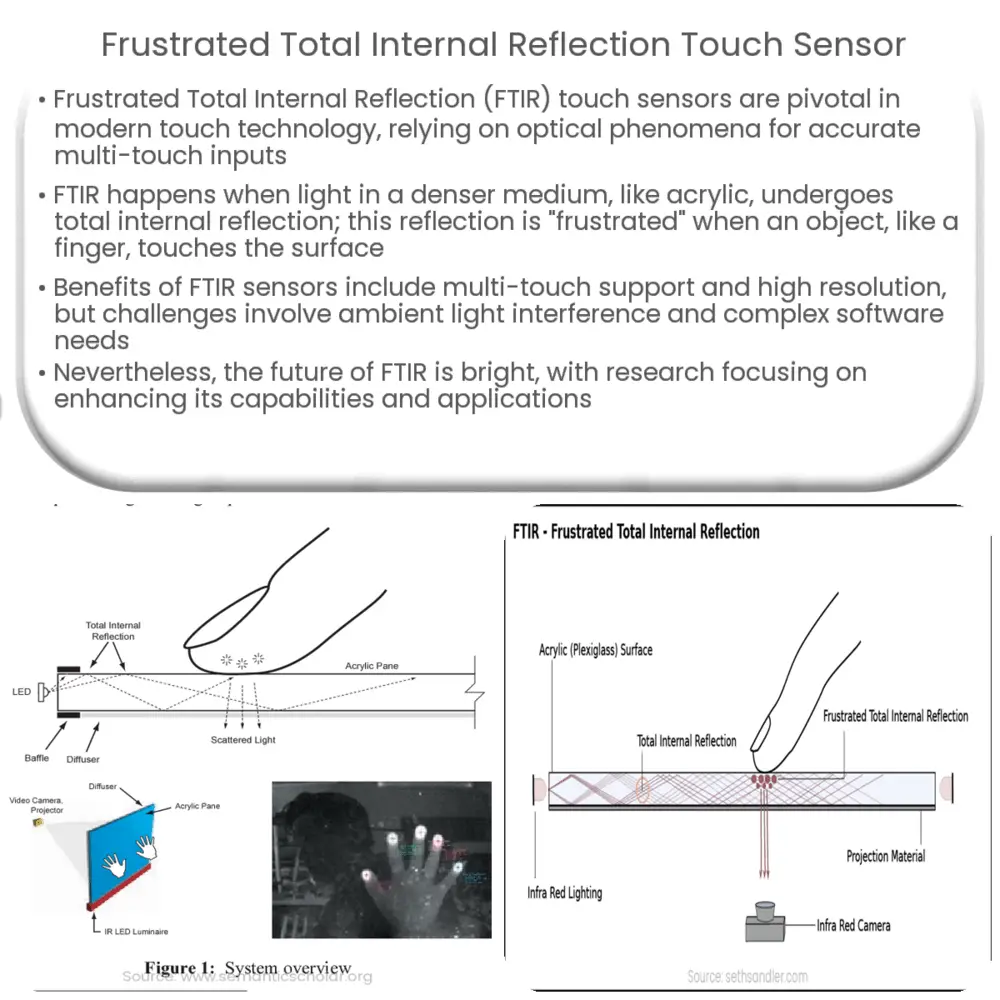Explore the principles of Frustrated Total Internal Reflection (FTIR) touch sensors, their applications, challenges, and future prospects.

Understanding the Basics of Frustrated Total Internal Reflection (FTIR) Touch Sensors
As the world swiftly embraces touch technology, it’s important to understand the underlying mechanisms that enable this seamless interaction between man and machine. One such mechanism is the Frustrated Total Internal Reflection (FTIR) touch sensor. FTIR is an optical phenomenon that forms the backbone of many modern touch devices, enabling accurate multi-touch inputs.
The Science Behind FTIR
Frustrated Total Internal Reflection is based on the principles of optics and light propagation. When light traveling through a denser medium (like acrylic) reaches a boundary with a less dense medium (like air), and the incident angle exceeds the so-called “critical angle”, total internal reflection (TIR) occurs. This means all the light is reflected back into the denser medium, with none of it passing into the less dense medium.
However, if an object comes into close proximity with the boundary surface – for example, a user’s finger touching a touch screen – the TIR gets “frustrated”. Some light is able to escape into the object (the finger), hence the term “frustrated” total internal reflection.
FTIR in Touch Sensing
In an FTIR touch sensor, a light source, usually infrared (IR), is injected into the edge of an acrylic panel. The light undergoes TIR within the panel and remains trapped until an object such as a fingertip comes into contact with the surface. This contact frustrates the TIR, scattering some of the light downwards, where it is detected by an infrared camera beneath the panel.
- The benefits of FTIR touch sensors include:
- Support for multi-touch: FTIR allows for simultaneous detection of multiple points of contact, making it ideal for modern touch interfaces.
- High resolution: Because detection is based on light scattering, FTIR can offer high-resolution touch sensing, allowing for precise inputs.
Despite these advantages, there are challenges that designers and manufacturers must overcome when implementing FTIR technology. These include issues with ambient light interference and the need for robust software to interpret the scattered light patterns accurately.
Challenges in Implementing FTIR
The successful implementation of FTIR touch sensing technology requires addressing a few significant challenges. One of these is the interference from ambient infrared light. Outdoor environments or other settings with strong IR sources can disrupt the sensing process, leading to inaccurate detections. Techniques such as frequency-based filtering and modulating the IR source can help mitigate these issues.
Another challenge is the need for robust and sophisticated software. The software is responsible for interpreting the scattered light patterns captured by the IR camera and translating them into touch events. This process involves complex image processing and pattern recognition algorithms. Furthermore, multi-touch inputs add an extra layer of complexity, requiring the software to accurately track multiple points of contact and their movements over time.
Future of FTIR in Touch Sensing
Despite the challenges, FTIR technology continues to advance and find applications in various fields. For instance, interactive displays, digital signage, and even certain medical devices are increasingly adopting this technology. FTIR has the potential to revolutionize these industries by providing more intuitive and immersive user experiences.
Research in FTIR technology is also ongoing, with efforts focused on improving sensitivity and resolution, reducing susceptibility to ambient light interference, and developing more efficient software algorithms for interpreting touch inputs. As these advancements materialize, we can expect to see FTIR touch sensors becoming even more commonplace in our daily interactions with technology.
Conclusion
In conclusion, Frustrated Total Internal Reflection (FTIR) touch sensors represent an important development in the realm of interactive technology. Based on the principles of optics, these sensors allow for accurate multi-touch inputs, providing a foundation for the touch-based devices that have become ubiquitous in our lives. Despite the challenges associated with ambient light interference and software complexity, the future of FTIR in touch sensing is promising, with ongoing research and development likely to further enhance its capabilities and applications. As technology continues to evolve, FTIR touch sensors will undoubtedly play a significant role in shaping our interactive experiences.

